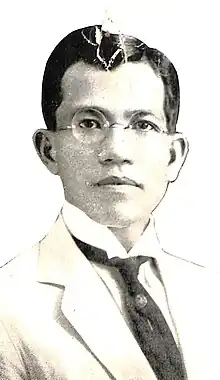Miguel Cornejo | |
|---|---|
 | |
| Member of the House of Representatives of the Philippine Islands from Mountain Province's Lone District | |
| In office 1922 – October 6, 1925 | |
| Governor‑General | Leonard Wood |
| Preceded by | Juan Cariño |
| Succeeded by | Juan Cailles |
| Municipal President of Pasay | |
| In office 1919 – 1922; 1928 – 1931 | |
| Preceded by | Pascual Villanueva |
| Succeeded by | Moises San Juan |
| Personal details | |
| Born | Miguel Cornejo y Reyes May 8, 1888 Manila, Captaincy General of the Philippines, Spanish Empire |
| Died | August 8, 1984 (aged 96) Manila, Philippines |
| Spouse(s) | Crisanta Soldevilla Paulita San Agustin Vicente
(m. 1974) |
| Profession | Politician Lawyer |
| Known for | Cornejo's Commonwealth Directory of the Philippines |
| Religion | Roman Catholicism |
| Military service | |
| Allegiance | |
| Branch/service | |
| Years of service | 1917-1918 |
| Rank | |
| Battles/wars | World War I |
Miguel Cornejo y Reyes (May 8, 1888 – August 8, 1984) was a Filipino soldier, politician, and lawyer. He served as Municipal President of Pasay and representative from Mountain Province. During the American Administration in the Philippines,[1] and after independence, as an attorney and legislator he championed many causes.[2][3] In 1939, he compiled and published the Cornejo's Commonwealth Directory of the Philippines, often used as an historical source for the period.[4] Earlier in his career, he served in the Philippine National Guard (PNG) in World War I after legislative enactment of the Militia Act on March 17, 1917.[2] After the war upon its disbandment, because the US Territorial government did not authorize a Philippine Army at the time, Miguel R. Cornejo, together with Manuel David, founded the military organization of the National Volunteers of the Philippines, leading as Brigadier General.[2][5] Descended from a prominent Spanish Filipino Mestizo Family, he spoke and authored many works in fluent Spanish, English[6] and Tagalog. He married Crisanta Soldevilla of Gasan, Marinduque.
Political career
Cornejo was a two-term Municipal President (Mayor) of Pasay, then a municipality in the province of Rizal.[7] He was first elected Municipal President in 1919. In 1922, at the end of his term as Municipal President, he was elected Representative of Mountain Province's Lone District for the 6th Philippine Legislature. However, he did not finish his term as he was removed from office by the Governor-General on October 6, 1925 after being convicted and sentenced to imprisonment for assaulting an American.[8] In 1928, he became Municipal President of Pasay once again, serving until 1931.[2]
During the 1930s, Cornejo was the leader of a minor fascist party, which in 1935 became one of the founding parties of the National Socialist Party. The party ran former Philippine President Emilio Aguinaldo as its candidate in the 1935 Philippine presidential election, which Aguinaldo lost to Nacionalista Party candidate Manuel L. Quezon.[9]
Personal life
On June 29, 1974, he married Paulita San Agustin Vicente in Pasay. Paulita also came from a distinct Spanish lineage. Their sponsors were Judge Pio Marcos and Mrs. Leonilla Garcia. He spent the rest of his remaining years with her in Sampaloc, Manila.
His direct descendants are spread all over the world, from Australia[10] to Miami, Florida, USA, Montgomery County Maryland, USA, as well as Ontario, Canada, and include singer Wency Cornejo; composer Dr Rodolfo Cornejo; Women Rights Champion and model Deniece Cornejo; late Naval Colonel and Paranaque politician Councilor Jess C Bustamante; former television personality Joaqui Mendoza; Papal Knight Sir Drexel Gregory; and GMA executive Rodrigo Cornejo. Another grandson, Gerardo "Gerry" Cornejo, was an award-winning professional photographer and is currently a TV and radio producer and program host in the Philippines.
References
Book - History of the Armed Forces of the Filipino People by Cesar P. Pobre. New Day Publishers, 2000. Pages 163, 171.*Pobre, C.P. (2000). History of the Armed Forces of the Filipino People. New Day Publishers. ISBN 9789711010416.
- ↑ Liang, Ta-pʻêng (1971-01-01). Philippine parties and politics: a historical study of national experience in democracy. Gladstone Co. p. 203.
- 1 2 3 4 Cornejo, Miguel R. (1939). Cornejo's Commonwealth Directory of the Philippines. Manila: Miguel R. Cornejo. pp. 192–198.
- ↑ Hearings. 1960-01-01. p. 78.
- ↑ Philippine eLib, Your access to the most comprehensive libraries in the Philippines and the world. http://www.elib.gov.ph/results.php?f=author&q=Cornejo%2C+Miguel+R.%2C++1888-
- ↑ Pobre, Cesar P. (2000-01-01). History of the Armed Forces of the Filipino People. New Day Publishers. p. 171. ISBN 9789711010416.
- ↑ Thompson, Roger M. (2003-01-01). Filipino English and Taglish: Language Switching from Multiple Perspectives. John Benjamins Publishing. p. 65. ISBN 978-9027248916.
- ↑ Pasay City-Islands Philippines. http://pasay.islandsphilippines.com/history.php
- ↑ "News of the World". Philippine Education Magazine. Vol. 22. Manila: Philippine Education Co. 1925. p. 321.
- ↑ https://news.abs-cbn.com/ancx/culture/spotlight/05/30/19/jewish-refugees-and-the-philippines.
{{cite web}}: Missing or empty|title=(help) - ↑ National Library of Australia. Catalogue. Cornejo's Commonwealth directory of the Philippines, compiled and edited by Miguel R. Cornejo. http://catalogue.nla.gov.au/Record/970814